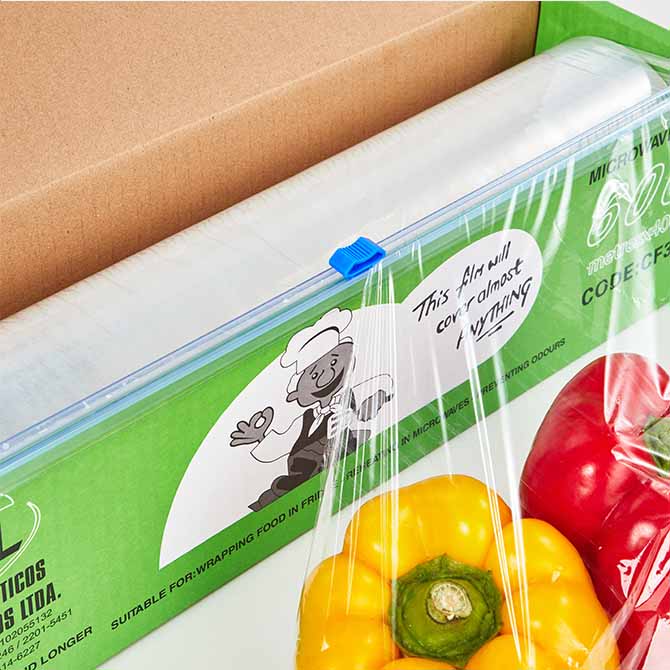We are committed to food packaging PVC cling film, PE cling film,stretch wrap, aluminum foil and other disposal food packing film/foil.

Language
>In today’s fast-paced kitchen environment, food safety and convenience go hand in hand. One of the most commonly used tools in both domestic and commercial kitchens is plastic wrap, also known as cling film or food wrap. But a pressing question often arises: will plastic wrap melt on hot food? This concern is not just about practicality; it directly affects food safety, hygiene, and consumer confidence. Here, we explore this question in depth and introduce Cling Food Wrap Manufacture, a leading supplier specializing in high-quality, certified plastic wraps suitable for all your culinary needs.

Understanding Cling Food Wrap
Cling food wrap is a thin, flexible, transparent plastic film used to cover and preserve food. It is typically made from polyvinyl chloride (PVC), low-density polyethylene (LDPE), or polyethylene (PE). Each material has unique properties that determine its heat resistance, stretchability, and cling performance.
PVC Wrap: Offers excellent cling and transparency but has a lower melting point (around 80–90°C / 176–194°F) compared to other materials.
LDPE Wrap: Known for its flexibility and heat resistance, it can withstand temperatures up to 100–120°C / 212–248°F.
PE Wrap: Highly stretchable and safe for freezer use, with moderate heat resistance (90–110°C / 194–230°F).
Understanding these properties is crucial for safe food handling, especially when wrapping hot or freshly cooked dishes.
The short answer: it depends on the temperature of the food and the type of wrap used.
Direct contact with boiling or extremely hot food (above 100°C / 212°F) can cause some plastic wraps to soften, deform, or even partially melt. This is particularly true for PVC-based wraps.
LDPE and PE wraps are more heat-resistant and may safely cover hot dishes up to 120°C / 248°F without deformation.
Microwave use: Many modern plastic wraps are designed to withstand microwave heat, but it is recommended to leave a small gap or vent to prevent direct contact with the hottest food surfaces.
At Cling Food Wrap Manufacture, each product undergoes rigorous heat resistance testing to ensure it performs safely under various kitchen conditions. Their cling films are designed to cling to containers without melting or transferring harmful chemicals, even when covering warm foods.
Food safety regulations are strict across the globe, and consumers deserve assurance that the products they use meet these standards. Cling Food Wrap Manufacture ensures all products comply with EU and LFGB certifications:
EU Food Contact Regulations: Guarantee that the wrap does not release harmful substances into food, even under heat exposure.
LFGB Certification (Germany): Ensures compliance with the strictest European standards for food contact materials, including chemical migration limits and safety under heat.
These certifications are critical, especially for professional kitchens, restaurants, and consumers who prioritize both safety and performance.
Even with high-quality, certified wraps, certain precautions should be observed when dealing with hot food:
Avoid Direct Contact: Place a layer of parchment paper or allow food to cool slightly before wrapping to minimize direct heat exposure.
Check the Temperature Rating: Ensure the wrap type matches the expected food temperature. LDPE or PE wraps are preferred for hot dishes.
Use Microwave-Safe Labels: Only use wraps specifically labeled as microwave-safe if reheating food in a microwave.
Vent for Steam: When covering hot food in the microwave, leave a corner open to allow steam to escape, preventing deformation or melting.
Store Properly: Keep wraps away from direct sunlight and heat sources to maintain performance and prevent early degradation.
By following these simple precautions, home cooks and professionals can safely use cling wrap without the risk of melting or compromising food quality.
Cling Food Wrap Manufacture has established itself as a trusted supplier due to its commitment to quality, performance, and safety. Key advantages include:
High Transparency: Allows for easy identification of food without unwrapping.
Strong Cling and Seal: Ensures airtight coverage, reducing spoilage and preserving freshness.
Flexible and Tear-Resistant: Easy to handle in various kitchen environments, whether for small containers or large food trays.
Heat-Resistant Design: Special formulations for LDPE and PE wraps enable safe use with warm or hot foods up to 120°C / 248°F.
Certified Safety: Compliance with EU & LFGB standards ensures food safety and chemical stability.
Applications in Modern Kitchens
The versatility of Cling Food Wrap Manufacture’s products makes them indispensable across multiple scenarios:
Home Kitchens: Wrapping leftovers, covering bowls, and protecting food in the fridge.
Restaurants and Catering: Covering prepared dishes before serving or storing in warming cabinets.
Food Industry: Packaging ready-to-eat meals and bakery products with safety and hygiene in mind.
Microwave Heating: Special microwave-safe wraps allow for reheating without compromising quality.
The question “Will plastic wrap melt on hot food?” depends on the material, heat level, and precautions taken. Cling Food Wrap Manufacture provides high-quality, certified solutions designed to withstand typical kitchen temperatures while ensuring safety and convenience. By selecting the right type of wrap—PVC, LDPE, or PE—and following best practices, consumers and professionals alike can confidently store, reheat, and serve food without worry.
With EU & LFGB certifications, transparency, and heat resistance, Cling Food Wrap Manufacture continues to lead the industry in providing safe, reliable, and versatile cling wrap solutions for every kitchen.